page 9
Progressive Thinkers as of 5/8/2020
|
| ||||||||||||||||||||||||||||||||||||||||||||||||||||||||||||||||||||||||||||||||||||||||||||||||||||||||||||||||||||||||||||||||||||||||||||||||||||||
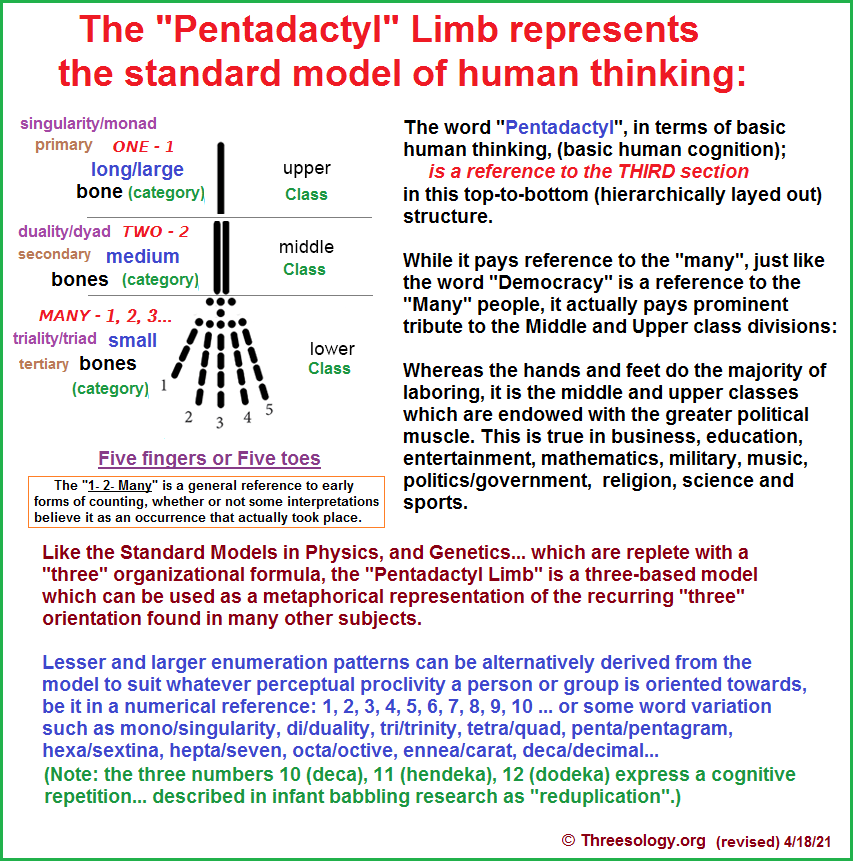
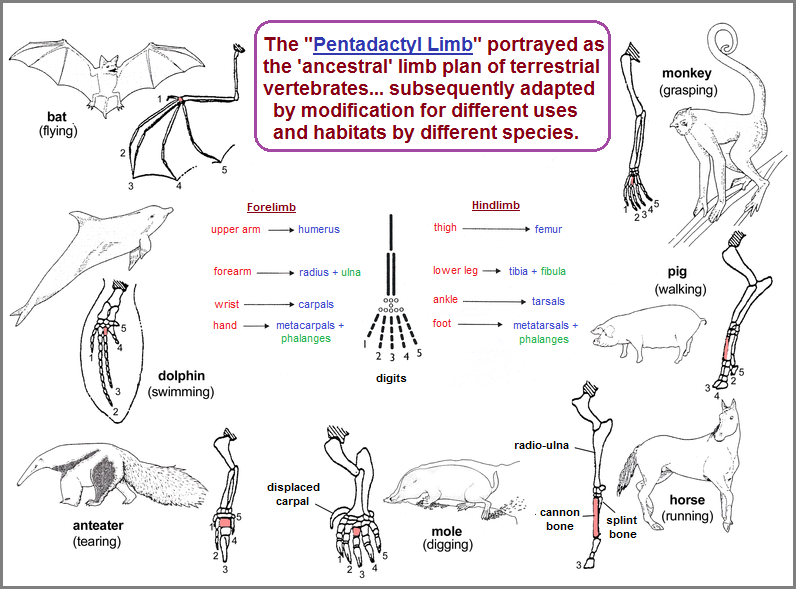
Looking for, identifying and cataloguing patterns is bothersome to some who observe you and would prefer that you were not thus engaged; because it makes it difficult for them to provide you with an illusion which intoxicates you to an extent you are disabled from any ability to reach a level of sober consciousness where you see through their nonsense patterns or the definitions or the applications thereof. We see such occurrences in Business, Politics, and Religion. The public is persuaded to wear the blinders of faith, or profit, or patriotism so as to perpetuate the grinding wheels of traditions which are withering away and seek to prop themselves up by permitting multiple fringe groups with adulterate inclinations either set the pace of the drumming to march by, the tempo of the steps, or the songs to be sung accompanied by banners and flags antithetical to any commonality except individualized perversions orgiastically practiced in crowds boasting a Nationalism of inverted, controverted, and convoluted prejudicialisms.
For example, the common pattern of thought since the 19th century has been to blame Capitalism for the public's many recurring ills. Nor is the ludicrously labeled "Big Government" since in a democracy, the entire population is said to be the government. No populous entity referring to itself as a Democracy can ever be small. Indeed, it is not Capitalism, since it is but a tool being used time and again for self-serving interests at the expense of the public. So too is this often the case to be found in Religion and Government. Neither Business, nor Government, nor Religion are to blame. It is the leadership of such institutions that are at fault. However, if such institutions are to be defined by their leaderships, then such institutions must also bear responsibility and are in need of eradication. No less, each institution has rigged its own system by which faulty leaderships are to be addressed; all but making the publics of the world totally impotent and intellectually incestuous for a placating participation. And this includes Judges. The legal systems of the world have created labyrinthine courses which enable institutional leaderships to either proffer and/or retreat to a safe haven commensurate with diplomatic immunity akin to a Monarchical-supported edict occasioned similarly like an ancient Diet of Worms which have continued to syphilitlically bore into the spirit of humanity; causing a Swiss-cheese like effect to debilitate its heart, mind and soul— which plays out like an echo (re-run) of events that occurred previously from one generation to the next but has gain such a momentum to create shorter passages of time that when reduced to decades have now become expressed from one election, or one business cycle, or one sermon to the next and now embraced as a social requirement like participants at a yo-yo tournament decided on by who can loop-to-loop the greater amount of times. (Granted that the metaphor may be lost on some readers who do not have the memory of such an event, nor that the "loop-to-loop" references a two-patterned repetition.)
In fact, many institutions are so out of touch with the public that the only way to get the public to defer to them is to set up conditions and consequences which forces the public to accept their views. For example, Religions don't actually want to end poverty, because suffering is good for the Religion business. The same goes for the U.S. government in its refusal to not only raise the minimum wage to a living wage, but address the problem concerning the need for cost controls, a maximum wage, a maximum profit (over-which all resources must be placed into a public coffer), and establishing term limits which are needed to curb the self-interest of politicians instead of public needs. No less, Business leaders are permitted to exploit the public because government permits the rich to get richer and the poor to get poorer. The business, government and religious institutions don't really care about the pattern you use to think in, so long as it involves the information of ideas as they set forth for you to think about.
Just because I have developed an interest in what may be called the "threes phenomena" (an interest established since childhood... or maybe before?); does not mean I overlook other patterns which I reduce to enumeration. I do so because of the quantity of items being listed. It is easy to use some non-enumerated cataloguing system if there are a few items or one is confident their memory will always be readily accessible. Others make their own collections but get tired in making an effort to pursue a collection beyond a point which they consciously or unconsciously entitle with a thought or feeling process equivalent to some measure of "many"; which references where their energy for collecting samples exceeds their accounting abilities or their limited accounting abilities limit how their energy is to be distributed. It is not too infrequent to find someone providing a list who will come to shortly stop and exclaim that there is a lot of, or "tons of" or "bunches of" or "hundreds of" examples, because they think there are and not because they have an actual list to provide. By making a claim there is some measure of enormity regarding a given item, and can convince themselves if not another that this is the case, they provide themselves with an excuse to overlook that there effort in making an honest effort is an expressed limitation. They reach a point of exhaustion in their collection and accoutring abilities and try to conceal such limitations by using words or phrases or actions that describe something which is supposedly larger than the collection and accounting abilities of anyone except someone or thing with a super-natural or machine-like ability.
Though I have had a sustained interest in the "threes phenomena", I have found it a need to play the part of a Devil's Advocate 1 and ask myself why the three pattern isn't everywhere if it is so important. For example, why do Astronomers use the label "Binary star system" instead of a "Trinary star system" or some other enumeratable pattern? Indeed, why do some observers of this two-patterned phenomena come to claim there are three types? ( Binary Stars)
- Visual: Which means you can actually see the tow stars in a telescope (no orbiting binaries have a wide enough separation to be seen with the naked eye);
- Spectroscopic: Which means you can see the presence of the orbit due to the Doppler (effect) shifting of the stellar spectral lines;
- Eclipsing: Which means you know there is a binary there because one gets in the other's way periodicall7 during its orbit.
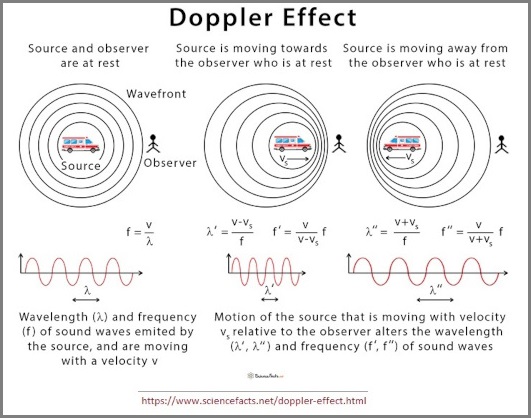
If say that we reference Binary instead of Trinary because that is what is occurring in Nature, at least Nature away from the Planet Earth, then does being on the Third planet in a solar system predispose its enclosed Nature to be predictively more three-patterned than two-patterned, or are such cognitive patterns subject to an evolutionary-styled variation themselves? In short, Astronomers say they see Binary stars because that is what they think they see, and so do others come to acknowledge a similar observation.
However, let us ask if they are simply exhibiting a two-patterned preferential orientation or that such a grouping is most dominant for a given orientation? In other words, do particle physicists see patterns-of-three in their subject because that is a dominant pattern or because they are just a group of people who have a preference for seeing their subject matter in groups of three?
Another example is why DNA has a double helix and a triplet code and not a triple helix and a doublet code, unless after all such two-patterned examples are examined, we find that there is some associated three-pattern which needs to be included in the observation because we are not being objective enough in our considerations of what should be included in our observations. It is like a child who holds a sock in one hand and a shoe in the other and does not make the psychic connection of placing them together in a given sequence for a given task to be accomplished. Whereas a double helix is well-noted as well as a triplet code, the two are not put together with a list of other ideas exhibiting a similar pattern and realizing there is a cognitive repetition taking place. In other words, if there is a dominant three-pattern and we find a two pattern, do we have a three versus two pattern or have a two- three pattern with a one or four pattern missing from our socially taught inclinations to perceive objects and ideas in a given way? Since there are instances of three-patterned ensembles with a one- two- three grouping as well as two- three- four, three- four- five; can it be our inclinations to focus on an idea in a singular way keep us from being more inclusive as to the presence of a larger entitlement grouping? Or that we notice a singular entity because either it is the last of a larger grouping or a larger grouping is yet to come at some later date?
Aside from the different trails of consideration concerning the shape and substance of different grouping patterns, the realization that we are practicing an overall limitation in the cognitive assemblage of different ideas suggests the presence of a conservation. It is not that we do not have the capacity to think alternatively, but we are being forced, as an adaptive requirement to deteriorating environmental conditions, to limit ourselves to recurring acts, activities, and thoughts. This would then explain why human history appears to be repeating itself, albeit with different characters wearing the costumes (clothing, hairstyles, superstitions, traditions, etc...) and accompaniments of different eras. Whereas we have creative ability, such ability is geared towards repeating something that had shown some favorability in a past, whereby some re-fashioned exposition is turned into a profitable sequel. Far too often instead of a genuinely new idea being created, we have creative people focusing their efforts on copying... by way of variation, someone else's variation of yet still another's variation of the same story that may have been developed in another century. Unless we are ready to claim that truly creative and original thinkers or developed skills are a rarity, and we prefer most everyone to mimic someone else as a requirement for receiving a label of normalcy with whom we can have some modicum of identification with; then we must... in either case, understand why humanity is repeating itself to the point of what appears to be an inevitable self-destruction.
What's wrong with humanity? Why do so many of us think humanity is a disgusting filthy animal and deserves all the misery it gets because it is a miserable creature whose selfishness and self-centered ness was long ago established in an institutional trinity called Business, Politics and Religion, which all other human activities have aligned themselves with, and developed concurrent rationales of acceptability which provides for perpetuating suffering, misery, destruction and even death? Why the repetition? Why for example do some South American countries perpetually elect someone to a high political office only to find that those chosen have been exploiting some resource to engender themselves with a private level of wealth, and that the practiced political system almost invariably allows for such individuals to achieve such a position of debilitating the public? Why indeed do similar scenarios play out in different countries in different ways and that the word "change" means little more than a change in the same type of actors and what garments they were, including the garments of language that are typically framed in condensed phrases or slogans?
Typically, we discuss humanity from either a business (economic: in the red/in the black), political (right/left), or religious (good/bad) perspective, and use science as a means to support one perspective or another. That's right, arguments generally become reduced to dichotomies, or patterns-of-two, while some try to create a compromise and thus enter a third option of consideration when very few observers question the overall validity of the dichotomies themselves as being representative of a recurring cognitive activity resembling an activity of conservation... of limitation... being imposed on humans. In order to overcome the pressures of the deteriorating environment, humanity must collectively focus all its energies and all its resources on removing itself from this planet, this solar system, and eventually the galaxy. Needless to say, it will probably be first undertaken by a single country, or group of investors, since the mood of humanity is presently so very self-centered and labeled as Nationalism, or racial or religiously ideological.
We repeat ourselves because we are being forced into playing out a role of conservation due to the survival requirements of living on a planet that is incrementally dying out. Forget the idea about associating human life cycles with a geological time scale, since we humans seem to be other than serially associated to such a scale. The idea that the human scale of life coincides with a geological time scale is an earlier model of the butterfly effect idea. Just because some major geological event occurs on some place on the planet doesn't mean the human genome records the event as if human genetics is akin to set of tree rings corresponding to geological activity. Comparing the human life span and cycle to weather events has a clearer and closer connection. It is geographical and not geological data coupled with environmental/weather data we need to be using as a yardstick of geometry by which we attempt to establish an infinitesimal calculus. For those who might argue that we can tie weather events to geology, one must wonder why they choose to support a geological time line if it is not that they were schooled to do so.
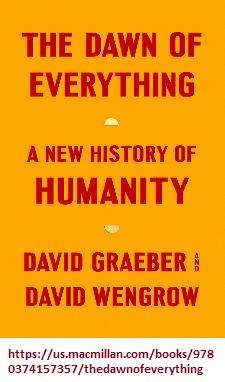
In the book "The Dawn of Everything", the authors note the repetition of human behavior but do not present the public with a list of examples indicating the presence of a recurring cognitive orientation which can be enumerated and show that there not only is a repetition, but a conservation of the small variants of repetition being employed by humanity; even though the general thesis attempts to elaborate an ability one would like to believe humanity possesses in terms of directing their lives (human society) along a more meaningful course instead of a recurrence of the "same old thing" dressed in era-specific garments to give the appearance of novelty and thus fruitful exceptionalism. Even though the authors resort to using a pattern-of-two and contrasting it with a preference for a pattern-of-three alternatives, they are oblivious to the cognitive disposition they are reflecting. Let me pride the excerpt from the first chapter one can find here: (The Dawn of Everything; The Dawn of Everything)
...It's just that collectively, we have learned it's to our advantage to prioritize our:
- long-term interests over our short-term instincts;
...or, better, to create laws to force us to confine our worst impulses to socially useful areas like the economy, while forbidding them everywhere else.
As the reader can probably detect from our tone, we don't much like the choice between these two alternatives. Our objections can be classified into three broad categories. As accounts of the general course of human history, they:
- simply aren't true;
- have dire political implications;
- make the past needlessly dull.
I wanted to include the above excerpt because of its similarity to the following examples being provided for an understanding of the existence of a standard cognitive formula which shows up in many guises, but reveals the presence of a conservation that, I believe, has to do with the incremental deteriorating environment we inhabit and will use rationalizations to try and dismiss the need for humanity to remove itself from its influences. Not in terms of what NASA or any equivalent government program would decide to be involved in and ultimately control as a tool for manipulating public attitudes and support; but as a government sponsored separate institution that recognizes that most, if not all Earth-based ideas will be a thing of the past once humanity's consciousness no longer has to be conserved by it, though living in space will present its own limitations until humans learn to circumvent these.
The following image references several different types of piano keyboard designs. The 88-key Grand Piano layout illustrates the 1- 2 -3 pattern grouped in Black keys, counting from left to right... while the White keys can be viewed as a "Many" compartmentalization. If one prefers to focus on other grouping patterns, the idea of 7 notes (ABCDEFG) may attract one's attention or the enumerated values of 52 for the white keys and the 36 for the black keys. A "52" reference might be loosely correlated with the well known 52 weeks of the year identity and the 36 with a roulette wheel, whose numbers... incidentally, add up to the infamous three-pattern of "666". Let us further note, as an aside reference, that there are 3 colors used on roulette wheels, there is a difference in the orientation of numbers used by the Americans and Europeans, as well as 3-part division of the numbers into groups of twelve.
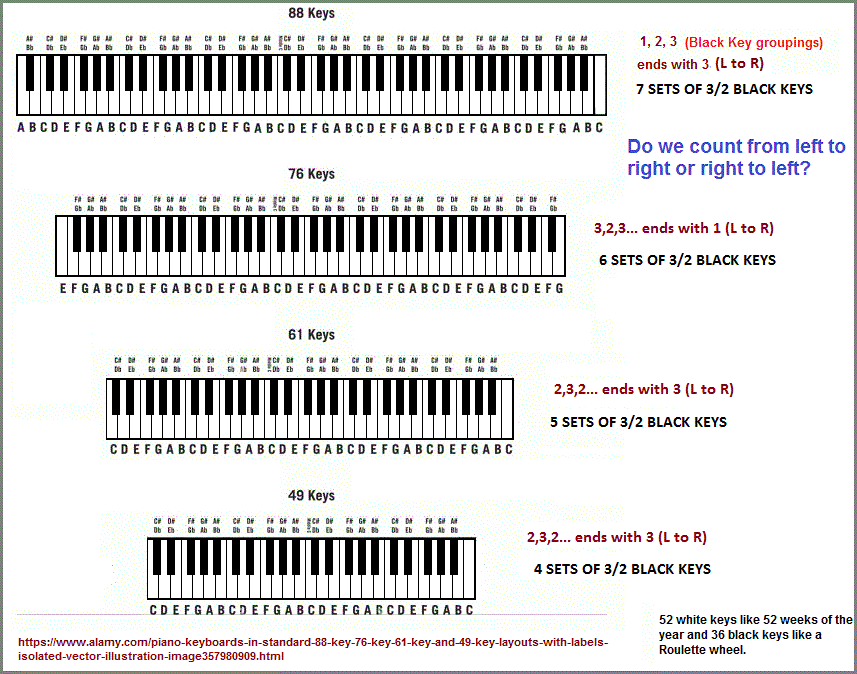
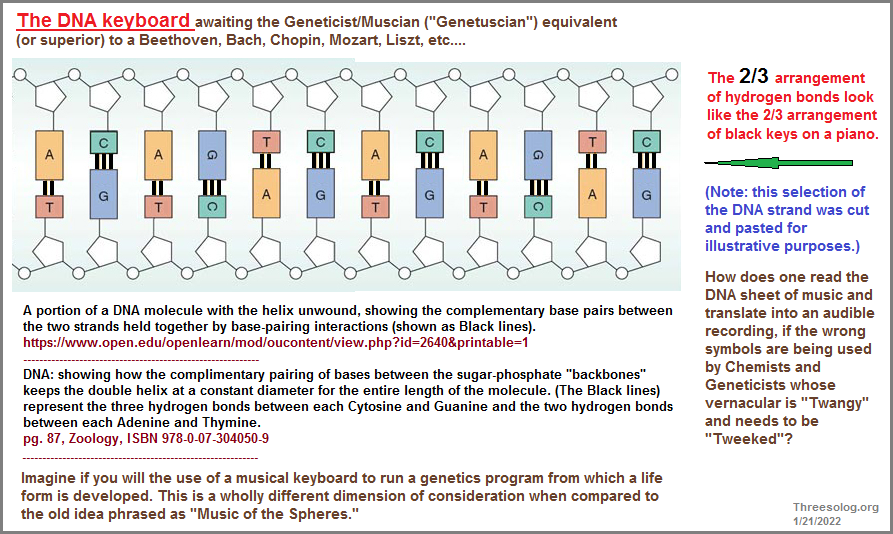
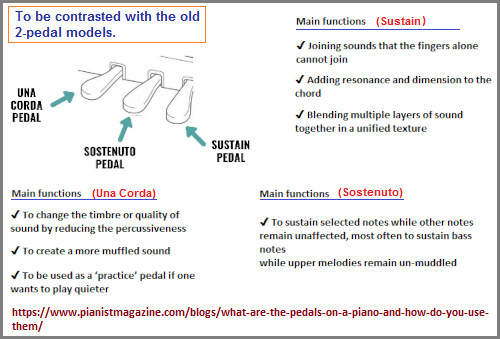
Apparently, the usage of two pedals became a recurring standard in later European models while a third (Middle) pedal was added later by (the later-born European linked) American manufacturing culture. If we look further back in time and associate the usage and naming of a third item with the practice of labeling individuals with their own names... (like the development and usage of a Dewey decimal system required when the population of books increased); let us note the cognitive development of humans in using a single name, then in some cases a double name, and in many (but not all) cases a third name, with more than three reserved for alternative descriptions such as using both a mother's and father's surname or due to a title. In several cases we find that a person becomes attached with an abbreviation that may be singular, double or triple. In fact, the names of gangs, clubs, associations, etc., has maintained this same cognitive orientation.
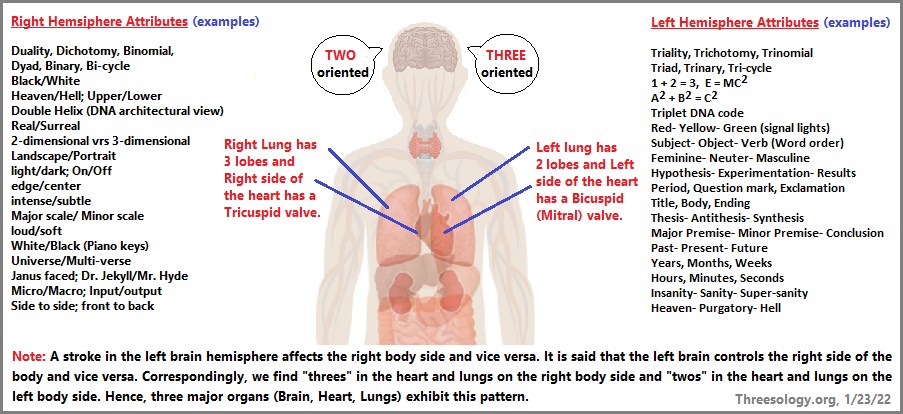
For a further reference to the above image see this page: Hybrids in Language 3. The body graphic came from here: Virus Organs Graphic.
An older reference to the "2 versus 3" idea can be seen on an image from Pompeii. This image and the one afterwards were culled from this page: The Devil's Advocate page 19:
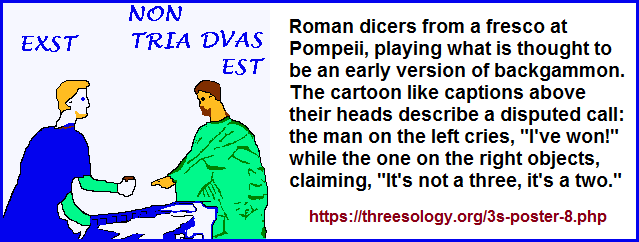
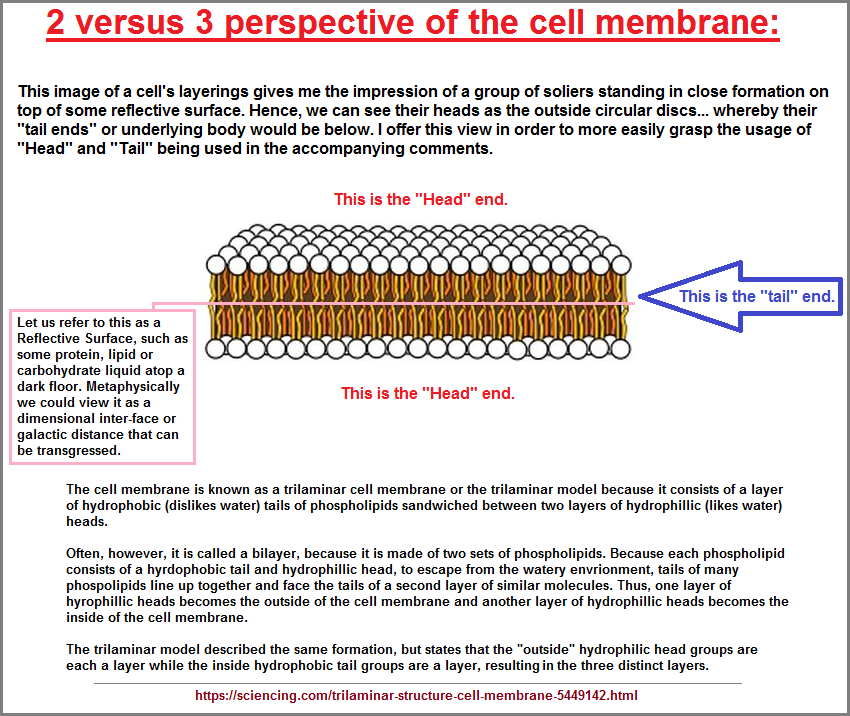
The adoption of a third element and a particular insistence on a "threes" orientation is said to be a given for the (Later born European linked) American (non-Native American) culture, with their (Earlier born) European counter-parts having had a previously established two-patterned focus and more primitive or earlier cultures (following the ascent of humanity's evolutionary advance); preferentially focused on the singular group "self"-survival identity. Multiple names for an individual are not needed in a small population, though a larger population may have a need for establishing a family name; such as having it designated as having the greater importance than any single individual, and may well refer to themselves first by supplying their last name... as in the case of many Traditional Chinese groups.
The point being is that we can see variations in which the underlying standard cognitive model exhibits itself in various applications and practices, accompanied by the necessary rationale and philosophical supports using either a monism/dualism, or monism/pluralism, or dualism/pluralism, or monism/dualism/tripleism, or triplism/pluralism, or some other combination which renders an underlying similar cognitive count that may use words which do not plainly represent enumeration. It's as if the human brain is carrying out some type of counting and sorting routine, even if most individuals are not conscious of doing so. It reminds me of birds or other animals who have been noted as having an ability to count and carry out their manner of "computation" in their daily lives seemingly oblivious to their activities involving repetitive counts. So too is the case for animals called humans. There are of course exceptions to the Standard Cognitive Pattern like there are exceptions found in other designated rules of thumb such as the Octet Rule in Chemistry, Fibonacci series rule in Botany, etc. Exceptions to a supposed rule may well be established as a cognitive rule itself, but as a rule, its presence on a graph aligned with other patterns may well be viewed as commensurably minor.
Many covalent molecules have central atoms that do not have eight electrons in their Lewis structures. These molecules fall into three categories: Exceptions to the Octet Rule
- Odd-electron molecules have an odd number of valence electrons and therefore have an unpaired electron.
- Electron-deficient molecules have a central atom with fewer electrons than needed for a noble gas configuration.
- Hypervalent molecules have a central atom that has more electrons than needed for a noble gas configuration.

Hmm, let us wonder if human cognitive development has the capacity to follow a Fibonacci sequence and would naturally do so if it weren't for the obstacles which some may say are created by business, political and religious indulgences, not to mention other interests... along with a deteriorating environment.
It should be mentioned although we think that the "DNA rule" (that all life forms have it), the hypothesis of a (single stranded) RNA world which preceded the present (double-stranded) DNA world, suggests there may well be a life form that is RNA positive without having any DNA. Due to the diversity of microbial life forms, where it is thought such a creature is best to be found. Does a DNA-less cellular organism exist on Earth? Akira Hiyoshi Kohji Miyahara, Chiaki Kato, Yasumi Ohshima
The 1-2-3 cognitive pattern (or its variations such as 1-2-many, 3 as 1, 3 into 1, 1 out of 3, etc...), is seen in the standardized usage of 3 pedals for pianos, whereas a two-pedal version had initially been introduced to the U.S.. Label it a trinity, a syllogism, a triple header or whatever, "three" convention you are most disposed towards, the three pedals can as well be viewed in terms of the dominant naming convention exhibited by the U.S.. One might view this from the perspective that earlier born cultures made use of a single name, the usage of two names was a later phenomena which was followed by the usage of three names as developed by the ancient Romans from which it is said the later born culture known as the U.S. adopted. This is not to say that the usage of more than three names [First (given name), Middle, Last (Surname)]; but such practices appear to be more in line with Ego-attenuated titles. Nor is a reference about a naming trend to claim that single and double names are not widely used in some cases... but that the one- two- three naming convention can be argued as another example of an existing cognitive model exhibited by the triplet code in DNA and the fact that life as we know it is on the 3rd planet from a source of solar energy. No less, there are occasions when a "one" or "1" reference becomes discarded or fused into one or more such that we may not have a three-patterned 1-2-3 ensemble, but a three-patterned The Devil's Advocate, page 14a (2-3-4 modeling), as well as can be seen in the three-patterned Pythagorean formula of 32 + 42 = 52. No less, the classic paper of George Miller's entitled The Magical Number Seven, Plus or Minus Two, is all too often overlooked as a three-patterned cognitive ensemble of 5-7-9. (7 - 2 = 5, 7 + 2 = 9)
Here are some references for Names, which shows the cognitive limits in this regard:
- History of Naming
- Surnames by Ellen Castelow (British culture surnames)
- Mononymous Person (Person with one name)
- U.S. Southern culture using double names (Billy jo, Mary Grace, Sue Ellen, Anna Claire, etc..)
- Roman Naming Conventions (The "tria nomina", the combination of praenomen, nomen, and cognomen that have come to be regarded as the basic elements of the Roman name.)
- On this page is a list of "street" gang names I compiled years ago: Criminal twos page 2
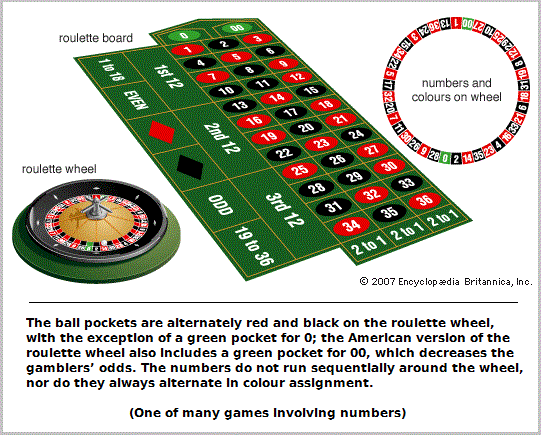
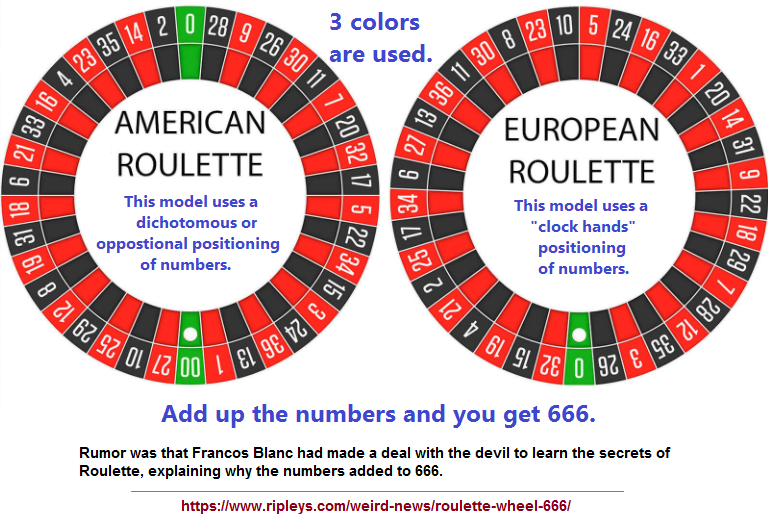
Why do the numbers on a Roulette wheel add up to 666?
Referencing the idea of a "One- Two- Three" pattern signified as a "One- Two- Many" phenomena where the word "many" can take on different labels such as varied, much, heap, more, a lot, bunch, etc., the fact that we can recognize such a pattern in the pterodactyl limb does not speak for instances which can well speak for themselves such as in the case of language (or speech) development. When we find a recurrence of the pattern in yet another faculty of the human physical dimensionality, it suggests there may be other occurrences which have not been catalogued nor become part of a discussion revolving around the origin of such a developmental pattern. Since it is not likely that a reader of this page would readily attribute the pattern towards an influence of thought, not so is the case when we find it occurring in a facility of language development where the idea that words influence thoughts, we need to address the recurring phenomena as a tell-tale sign that something more fundamental has occasioned such an existence, and how it may well play out in other sociological concerns involving business, government and religion.
Whereas we can see the pattern in the development of using words to describe quantities which later become associated with some numerical referencing symbology such as a line, notch, circle, etc., the fact that we come to use such a pattern to organized perceived behavioral activity may not be a coincidence and have a meaning beyond the initial design and usage, as if the "One- Two- Many" is an utterance of speech related to some cognitive function for which we humans in our present state of evolution grope crudely with in our attempts to convey some indistinct image bounding back on the walls in our psyche, like a moving shadow seen from the perspective of someone watching the passage of the Sun as it exerts itself as a shadow on a wall. In any respect, it will be useful for some readers to become aware of language development stages, where the "One- Two- Many" can be easily differentiated:

Let's explore the attempt to define the parameters of a proposed Standard Cognitive Model with respect to a pattern-of-three Linear, Circular, Triangular conformation; viewing it as one of several approximations devised by the human brain. However, it is to be noted that when I say "standard", I am not also claiming some easily referenced identical form. Creativity, serendipity and originality can come into play just as does mediocrity. And though I say "standard Cognitive Model", it might appear to some readers that the last word (Model) should be pluralized to read "Models"; since the standard appears to be made up of multiple ensembles which we can collate together by looking upon human perception and mental activity as one might view and use an artist's color palette, fisherman's tackle box of lures, or even the famous "box of stuff" set aside at the back of a closet, top of a shelf, placed in a shed, the garage, attic, basement... or set nearby such as a kitchen "junk drawer".
This being said, we need to be somewhat flexible in our thinking since "different similar" (or is that "similarly different"?) ideas cropping up under different circumstances (such as attitudes and preferences for traditional designations)... can be labeled and dressed differently. An expressed idea can sometimes take on an embellished abstraction, "stick man" or seemingly non-syndical doodling configuration... as well as various interminglings of language and ideas from different subjects combined together, used as substitutions, whittled on, etc... And yet, for those wondering, the usage of mathematics as an attempted standard model of thinking is problematic, because mathematics is itself a recurring pattern that is not being viewed as a variable, along with the recurring emphasis to use linear and static equations to represent dynamic and non-linear processes. The basic patterns of mathematics are being excluded from being recognized as variables in equations. It requires a different type of Calculus to do this.

A standard cognitive model apparently contains ensembles of three in which three forms can interact, inter-mingle, overlap, inter-play, and produce other types of conjugations that may be alternatively termed as a 3 in 1 ratio, instead of as a 3 "to" 1, 3 "from" 1, 3 "and" 1, 3 "also" 1, etc..., such that reversals of this may be linguistically portrayed as well as derivations. Fore example, 3 minus 1 3 times1, 3 divided by 1, 1-cubed, etc... An example of how a given pattern such as the idea of "three being represented by one" can crop up in multiple scenarios in different cultures in different time periods in different subjects and be portrayed in a modern setting, is found in the physics idea of The Grand Unified Theory (GUT); where the three forces (electro-magnetism, strong, weak) are considered as possibly being one force. Hence, this 3 being 1 can be viewed as a type of ratio, with alternative words and symbols placed between the two values, as one might place the word "unity" between the values of Yin and Yang.
The "Yin and Yang" idea is often considered as a list of opposites, though not infrequently viewed as complimentary and complementary items with great utility, and might well be viewed as an early attempt to devise a standard by which all of life can be and should be viewed. However, I see the Yin/Yang idea as but one of three pattern-of-two profiles, which should be of interest for those who contemplate the notion of opposites:
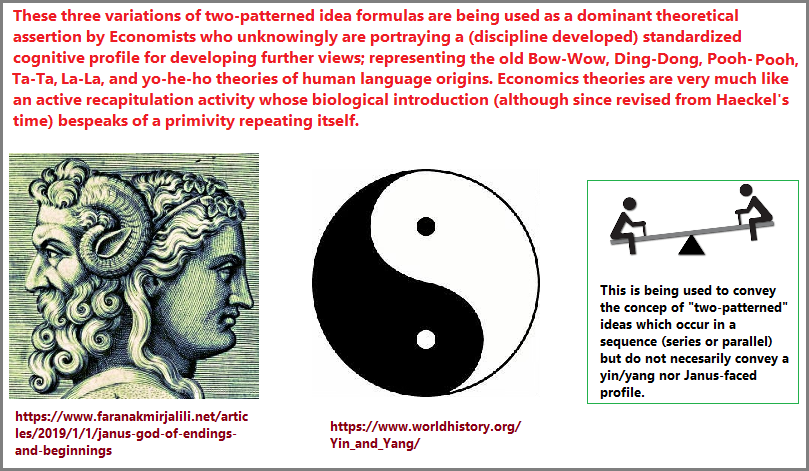
Clearly, the hot/cold, wet/dry, stormy/calm, etc... climates of Earth along with the bipedal (pendulum) influences of the human gait have contributed to a retention of the old double-entry cognitive pattern seen in religions, politics (such as political factions), fashion, dance, sexual orientation (the "Pride" community is even more primitive with its advocacy of single entry accounting), and multiple other human activities. Nonetheless, though most people take opposites or patterns-of-two for granted, and one can surmise that individual perception can determine the definition of what is meant by opposition, let us attempt to conjecture the existence of a finite quantity of the "two", irrespective of the labeling one might select to appropriate as the preferred vernacular, in that there is a lingua franca of kinds one might be able to deduce. For example, we have the oppositional form of the "two" as expressed by the Yin/Yang profile. We also have the series type of two such as in the case of a one- two progression, though we might wrestle for a time with the two-pattern represented in the fashion of a direct current example with its direct positive and negative orientations. With this in mind we come to a "two" in which a type of reversal appears that we might denote as Alternating current. From these observations one might step in the direction of allocating to our collection of twos, the item we call parallel, or a side-by-side pattern-of-two. And if we think about an inter-dimensional linkage, it is not certain whether we have actually found a different type of "two-pattern" or just an elaboration of one or another already cited in our three-dimensional perspective. By extension, if we view the "two" in relation to the three movements one might use when changing the direction of a chess piece, can we thus define the "two" in terms of a horizontal, vertical and diagonal frame of reference which then details three different possible types or kinds of the "two"?
It is not difficult to see that the Grand Unified theory is a 3 to 1 ratio which can be detected as a basic cognitive pattern being used in other subjects, but that those using such a pattern in their preferred subject and context, might well view the pattern with great distinction and not as a recurring theme of human mental activity. As it stands, the pattern can be viewed as a fixed (but flexible/adaptable) organizational theme which becomes used in different contexts and thus may be labeled differently, as well as exhibit other illustrative portraits. For example, instead of "one" the word singularity might be used. And instead of "three" the word many, plenty, heap, few, much might be used. Clearly, the GUT idea in physics is a 3 in 1 idea and dawns the dress, mannerisms and language consistent with the subject in which the basic pattern is cropping up.
Again, to reemphasize the previous point, let us note that the "Three", from some perspectives of looking at the history of counting, can be viewed as the word "Many", such as in the (three-part) primitive counting scheme of "One- Two- Many". Hence, the word "third" is this linguistic phrase is a substitution for the third item. Whereas some readers might want to argue that the "Many" in the foregoing sequence refers to 3 or more, the fact that the phrase is a three-patterned expression itself, can be viewed as a correlation to the idea of a set-of-three, ... such that the U.S. motto E pluribus unum (Latin for "out of many, one"), can be referenced as a symbolic model of the 3 in 1 idea... yet there are several others: Three to One ratios page A.
Without suitable references from other cultures such as the Asian and African which provide "three-to-one" references, regardless of guises, it is of value to tentatively describe the expression as being related to Indo-European peoples, and thus suggests a long-term linguistic transference through time which has established the illustration as a cognitive theme. The Grand Unified Theory is thus a type of cognitive construction being processed which has a history in Indo-European cultures (that other cultures may have borrowed... unless we find evidence that the opposite is true). For example the idea of the Christian Trinity is such that it is sometimes explained as three persons in one godhead. Prior to this idea was the view... one might assume, that the Sun was made up of three "moments" or phrases (Dawn- Noon- Dusk). Gregor Mendel established the idea of a 3 to 1 ratio in biology.

To me, the "3 in 1" (or 1 from 3, etc...), is so similar in number variables to the expressions "3 to 1", 3 and 1, etc., that I am inclined to view them in the same context of cognitive usage. As the human brain allows for a wider berth of accommodation for particular cognitive themes as a recurring pattern of familiarity as one might use a particular phrase, piece of clothing, mannerism, etc., as an identification. While distinctions may be made on separate applications to satisfy those who are obsessed with a cognitive theme being expressed in a particular way, I think the two (and other variations) are close enough that the human brain categorizes all of them with a "look alike/sound alike" quality, though some readers swear that "tomato and tomahto" are differences which constitute a dissimilarity of great importance. Nonetheless, the phrase 3 in 1... to me, can also be viewed as 3 and, from, out of, into, etc., 1. Hence, when I see us using a comma to separate three items, even though in language we call it a series of three and in mathematics we call it a set of three, the same basic idea is being referenced. Likewise when I see that both DNA and RNA have the same three amino acids, and then are distinguished by as separate one [respectively: Thymine/Uracil], the usage of some to call the association a group of four instead of a three-to-one ratio does not change the fact that the human mind has configured perceptions in a similar way. The Grand Unified Theory in physics may be an idea which references a linguistic tradition of a similar cognitive behavior that we might want to reference as a (part of a) Standard Cognitive model.
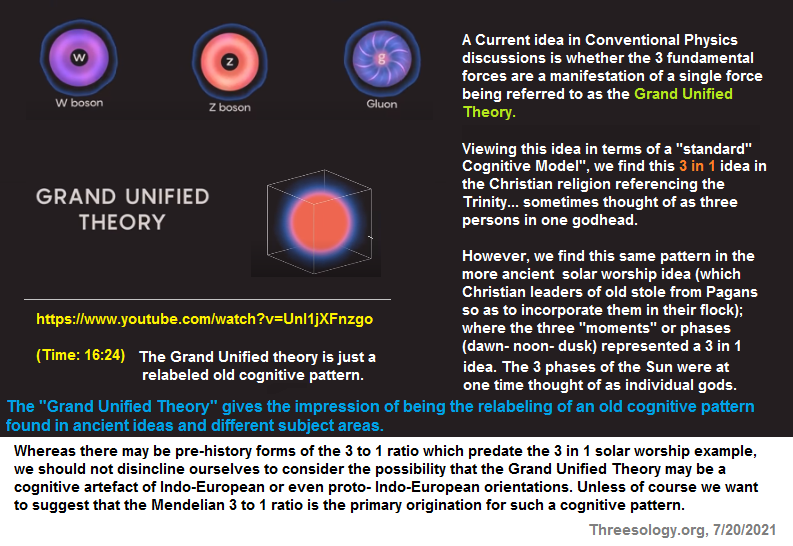
Despite those readers who are inclined to describe four forces and four directions and four amino acids instead of a "three" theme, let me again point out that there needs to be a "3-to-1" label of referencing placed into our research and descriptive formulas. Three items can be distinguished from a single one, if not by place of position, activity, labeling or use of some conventionalized demarcation such as a comma, then by a deliberate act of seeking to review our ideas in an alternative manner. Hence, when viewing the 3/1 (or: 3\1 or: 3_1 or 3:1, etc...) we have such examples as:
Here are some various 3 to 1 examples meant to be shown as a recurring cognitive pattern showing up in different guises. Recurring cognitive patterns illustrate recurring environmental and social pressures being created by and subjected to the incremental deteriorations of the Sun (it's burning out), Earth (it's rotation is slowing), and the Moon (it is receding); to which humans produce rationalizations (such as business, politics, religion... superstitions, traditions, holidays... etc.) as a make-shift survival mechanism and an attempted coping mechanism.
- Three: Electro-magnetism, Strong, weak forces... One: differentiated Gravity force (Why Gravity Is Not Like the Other Forces)
- Three: North, South, East... (demarcated by a comma) One: West
- Three: (the same amino acids) Adenosine, Cytosine, Guanine... One: (differentiated single amino acids) (DNA = Thymine), (RNA = Uracil)
- Three: Stop codon amino acids... One: Start codon amino acid
- Three: (A colloquialism) "We teach the ABC's"... One: All the rest of the alphabet is not typically used to describe teaching the alphabet.
- Three: ones, tens, hundreds... One: (demarcated by a comma) before the thousands is placed... and then the sequence repeats like a babbled utterance.
- Three: "For he's a jolly good fellow" (repeated 3 times)... One: (followed by the phrase:) "For which nobody can deny"
- Three: Dawn- Noon- Dusk... One: Sun (Three "moments" of phases in one Sun.)
- Three: Solids, Liquids, Gases... One: Plasma
- Three: (spatial dimensions) Depth, Width, Height or Width, Breadth, Height; (point, line, plane) [3 dichotomies: up and down, left and right, back and forth]... One: Time (dimension)
- Three: Length, Width, Height... One: Volume
- Three In One: The gas laws consist of three primary laws: Charles' Law, Boyle's Law and Avogadro's Law (all of which will later combine into the General Gas Equation and Ideal Gas Law). The three fundamental gas laws discover the relationship of pressure, temperature, volume and amount of gas. ( Gas Laws). Gay-Lussac's Law refers to an ideal Gas. Other laws deal with Real or actual laws. Hence, a dichotomy is differentiated.
- Three: Father- Son- Holy Spirit... One: God (Three persons in one god-head)
- Three: Three main engines... One: Space Shuttle (Three rocket engines in one space shuttle.)
- Childhood game of four-square features four possible players with one acting as the initial server of the ball.
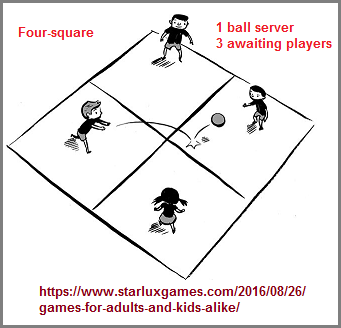
- Three: Premium, Mid-grade, Regular (gasoline)... One: Diesel fuel oil
- Playing three to one: British slang referencing the penis and two testicles set against the one vagina.
- Three: A protein's sequence of amino acids (or primary structure), determines Secondary and Tertiary structures. All proteins have primary, secondary and tertiary structure... One: Some proteins are made up of more than one amino acid chain, giving them a quaternary structure. (Protein Structure Tutorials)
- Three: Buy three tires... One: Get one free (or for a dollar)

- Whalefish Researchers have discovered that a group of deep-sea fishes previously classified into three separate families are actually the larvae, males, and females of a single family -- the whalefishes. (Researchers show that three fish families are actually one)
- War time perspective: Never light three cigarettes with one match (because a sniper can then locate your position). Phrase Finder: Three on a match
- Myth: You are never more than three feet from a (at least one) spider. ( Myth: You're always within three feet of a spider)
- The One infamous electric eel is actually three distinct species. (The Truth About Electric Eels Has Long Been Overlooked)
- Three: Matthew, Mark, and Luke are called the Synoptic Gospels... One: John is called the idiosyncratic gospel.
- Three: Superman, Perry White, Jimmy Olsen... One: Lois lane (Superman television series of the 1950s in the U.S.; Three main male characters to one main female characters.)
- ETC...
3 commonly referred to monkeys: See, Hear, Speak no evil 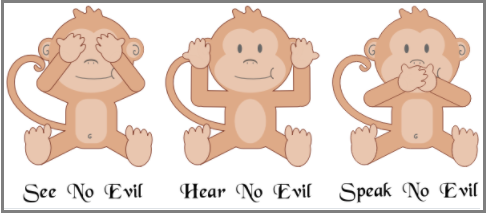 https://openclipart.org/detail/283580/4-monkeys-improved |
1 commonly unknown Monkey: Do no evil  |
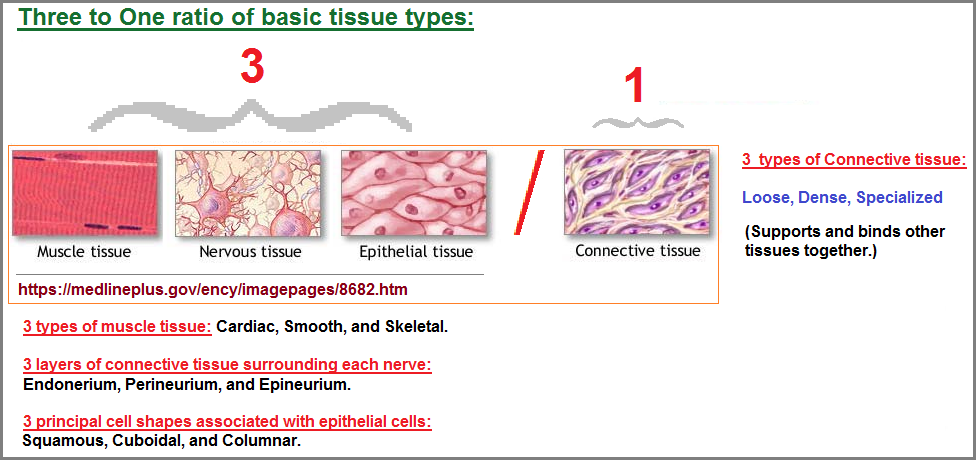
Date of (series) Origination: Saturday, 14th March 2020... 6:11 AM
Date of Initial Posting: Friday, 8th May 2020... 4:48 PM
Updated Posting: Friday, 4th February, 2022... 11:16 AM